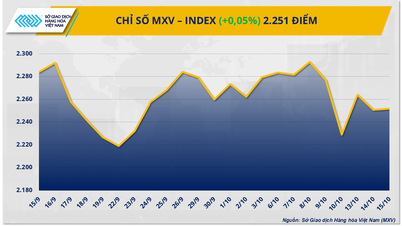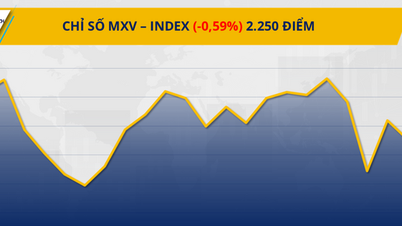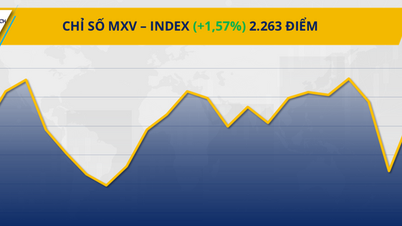
According to a VNA reporter in New York, at the end of the trading session on October 16, the price of West Texas Intermediate (WTI) light sweet crude oil for December delivery fell to 56.99 USD/barrel, down 2.2% from the opening time of the session and down 19% compared to the same period last year, the lowest level since February 2021.
This week’s decline has pushed oil prices lower than they were during the spring selloff, when President Donald Trump announced plans for reciprocal tariffs, raising concerns about global economic uncertainty. The decline is good news for American consumers, as cheaper crude oil drives down prices for gasoline, diesel, jet fuel, and heating oil. But it’s a worrying sign for the U.S. oil industry, which is already suffering from shrinking profit margins and thousands of job losses.
Oil prices have fallen due to a number of factors, most notably concerns about oversupply and the risk of a resurgence of the US-China trade war. According to the International Energy Agency (IEA), oil inventories at sea increased by about 3.4 million barrels per day in September, the largest increase since the pandemic.
The IEA and other energy market forecasters expect the glut to widen in the coming months as producers from the Middle East to Texas continue pumping oil despite plummeting prices. The latest IEA data shows U.S. oil production hit a new record of more than 13.6 million barrels a day in July.
Meanwhile, the Organization of the Petroleum Exporting Countries and its allies (OPEC+) reversed a decision to cut production – a process that had been initiated in 2023, when energy prices fell from their peak after the outbreak of the Russia-Ukraine conflict. OPEC's goal is to regain market share from independent producers in the US, Brazil, Guyana and other countries – rivals that OPEC has repeatedly faced in oil price wars over the past decade.
The negative developments in US-China relations have also created new concerns, threatening the outlook for global economic growth. The world's two largest economies have issued tough statements and countermeasures related to tariff policies, causing trade tensions to increase.
Gold therefore continues to be considered a safe haven and continues to set new price peaks in the session of October 16 (US time), while major US stock indexes fell simultaneously due to the decline of financial stocks.
Spot gold rose 2.4% to $4,308.51 an ounce, while US gold futures rose 2.95% to close at $4,300 an ounce. The precious metal's strong performance was fueled by a weaker US dollar, low interest rates and investor caution amid geopolitical uncertainties.
Trade tensions are prompting central banks to increase their purchases of gold, Sam Stovall, chief strategist at CFRA Research in New York, said. “This is not necessarily a reaction to concerns about the global economy, but rather political uncertainty,” he said.
In the stock market, major US indexes fell across the board after financial stocks posted weak results. Shares of insurer Travelers fell, while Zions Bancorp reported a $50 million loss in the third quarter of 2025, pulling the financial sector index down 2.75%.
The Dow Jones Industrial Average fell 301.07 points, or 0.65 percent, to 45,952.24; the S&P 500 fell 0.63 percent, to 6,629.08; and the Nasdaq Composite dropped 0.47 percent, to 22,562.54.
“Without much new economic data, investors are looking at bank results as a proxy,” said Chuck Carlson, CEO of Horizon Investment Services in Indiana. “Credit-sensitive stocks are falling sharply, possibly due to concerns about deteriorating credit quality.”
“The dollar is weak and cryptocurrencies are falling. The market is in a risk-off mode. Signs of a cooling labor market seem to support the case for easing monetary policy,” Carlson said.
Federal Reserve (Fed) Governor Christopher Waller said on October 16 that the Fed should continue to lower its policy interest rate by another 25 basis points at the end of this month's monetary policy meeting, scheduled to take place on October 29.
The USD weakened against the euro and Japanese yen, specifically the USD index decreased 0.33% to 98.35 points; the euro increased 0.36% to 1.1688 USD; and the yen increased 0.43% against the USD, to 150.39 yen per USD.
U.S. Treasury yields fell, with the two-year yield falling to its lowest in more than three years. The 10-year yield fell 6.9 basis points to 3.976%, while the 30-year yield fell 5 basis points to 4.5891%.
In Europe, major indexes rose as investors welcomed positive earnings results and sentiment stabilized after French Prime Minister Sebastien Lecornu survived a no-confidence vote. The STOXX 600 index rose 0.69%, while the FTSEurofirst 300 index rose 0.68%.
Source: https://baotintuc.vn/thi-truong-tien-te/gia-dau-cham-day-trong-gan-5-nam-vang-vuot-nguong-4300-usdounce-20251017091358219.htm



![[Photo] Collecting waste, sowing green seeds](https://vphoto.vietnam.vn/thumb/1200x675/vietnam/resource/IMAGE/2025/10/18/1760786475497_ndo_br_1-jpg.webp)


![[Photo] General Secretary To Lam attends the 95th Anniversary of the Party Central Office's Traditional Day](https://vphoto.vietnam.vn/thumb/1200x675/vietnam/resource/IMAGE/2025/10/18/1760784671836_a1-bnd-4476-1940-jpg.webp)
![[Photo] Closing ceremony of the 18th Congress of Hanoi Party Committee](https://vphoto.vietnam.vn/thumb/1200x675/vietnam/resource/IMAGE/2025/10/17/1760704850107_ndo_br_1-jpg.webp)

































































































Comment (0)